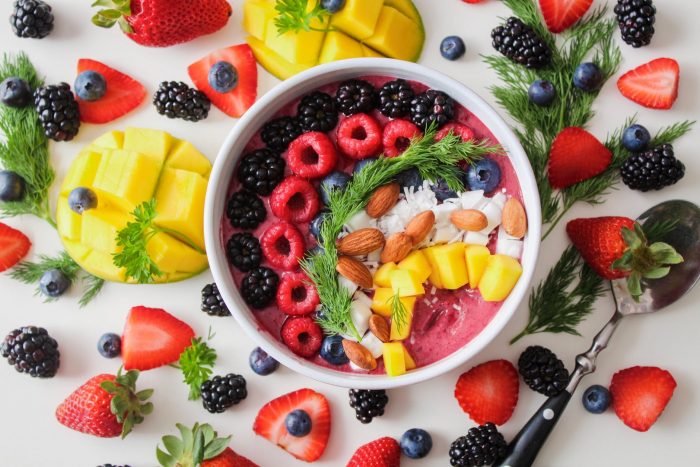The skincare industry brings in an estimated $180 billion dollars a year – so to say that we prioritise good skin would be a bit of an understatement. With countless cosmetics promising to all but save our souls, it’s hard to remember that our skin is a living part of us. And with the futuristic allure of renewing skin and defying age, why would we look anywhere other than a bottle for results?
In reality, what we put into our bodies makes a hell of a lot more difference than what we put ON it ever could. Our skin is still an organ; and although they say the way to a man’s heart is through his stomach – in reality it’s the way to his skin. What you eat is the biggest factor in how your skin will look – something that we forget when confronted with godlike celebrities brandishing glowing elixirs. We all know that coconut water will leave you looking like a victoria’s secret model – but here’s the food you might be missing of your list…
Olive oil:
In terms of skin (and general health) olive oil is our fat favourite, and a sly old superfood. Olive oil contains 3 major antioxidants; polyphenols, phytosterols and Vitamin E, all of which help to combat ageing effects and smooth out skin. As an oil it doesn’t clog your pores or increase your chances of oily skin, and it also helps to moisturise your skin and improve the health of your organs, leading to overall better skin health. (1)
Tomatoes:
Tomatoes are full of a phytochemical called lycopene, which helps to guard against free radicals caused by UV rays (They protect you from the sun, in case that went over your head…) (2)
Dark chocolate:
Dark chocolate is great for your health for a variety of reasons, but skin-specifically, it contains antioxidants called Flavonoids which (again) protect against free radicals and UV rays, as well as hydrating your skin and keeping it dewy. (3) Plus, it’s chocolate and science is giving you the OK, which is always a win.
Sardines:
A more acquired taste for some, but these little fish are amazing for your skin. Sardines contain high levels of Omega-3, (which gives a youthful look to skin as well as seriously helping with acne and psoriasis) iron, protein, calcium, and B12. (4) Basically, sardines are royalty in the mineral world, so if you’ve acquired the taste, go for it!
Green tea:
Green tea is infamous for its detoxing benefits – and it definitely doesn’t disappoint in the world of skin. It contains multiple antioxidants (polyphenols, phytochemicals, enzymes and amino acids) while also having B vitamins, potassium, magnesium, caffeine, manganese, and folate. (5) Green tea also improves complexion, elasticity, de-puffs eyes, reduces dark circles, fights against ageing, reduces acne and breakouts, protects against the sun and helps to shrink pores. Long story short, you name it; Green tea fixes it.
Kale:
We never stop hearing about this little leaf in the health world, and we’re hearing about it again now. Kale contains copper (which protects against the sun), Vitamin A (which improves your skin’s ability to regenerate) and Vitamin C (which helps your collagen production) (6) In a cup full of kale you can find 134% of the Vitamin C for your RDA, and 133% of your Vitamin A.
Walnuts:
Walnuts are one of the healthiest nuts, containing high levels of omega-3, which help reduce eczema, keep your skin moisturised and protect against UV rays. (7)
Mackerel:
Similarly to sardines, mackerel contains lots of B12, which can reduce hyper pigmentation and works as an anti inflammatory against redness, itching, eczema and other skin conditions. (8)
Carrots:
Not only do carrots contain Vitamin A and help to repair damaged skin cells – they can also help to add a golden hue to your skin, making you look especially radiant and healthy. (9)
And to make space for all this new food in your diet, here’s the stuff that you’ll want to lose:
Refined carbohydrates:
On the long list of reasons to avoid simple carbs, your skin made the cut. Refined carbs feed the bad bacteria in your gut, which plays havoc on acne and can cause problems in your digestive system and organs. Refined carbs also cause excessive oil production (due to insulin spikes) and clog pores, while increasing ageing effects, because the sugars become codependent and latch onto cells like collagen and reduce their effectivity. The spikes in insulin can also cause problems with kidneys, which are linked to breakouts.
Dairy:
A routine offender, dairy is public enemy number one for skin. Scientists estimate that 75% of the world’s population is lactose intolerant (with varying degrees of severity) so for most of us dairy products cause breakouts as a means for our body to signify there is something wrong and detox. (10) Dairy products are also pro-inflammatory, so they aggravate existing conditions like eczema or psoriasis, and acne is especially affected, as dairy products usually contain antibiotics and growth hormones, which confuse your natural hormones and flare up acne. Dairy products also contain high levels of fat, which will flare up breakouts.
Soy:
Yep, milk is a minefield; not only is cow’s milk bad for your skin, but soy milk can be too. Products that contain soy contain phytoestrogens (a mimic of estrogen) which can lead to excessive estrogen and acne, confusing your hormones in a similar way to milk. Your skin can also break out in a warning style reaction because nearly 90% of the world’s supply of soy is now genetically engineered, and our skin generally reacts to anything unnatural.
Sugar:
Surprised? Didn’t think so. Sugar spikes your insulin in the same way refined carbs do, causing excessive oil and clogged pores. (11) Again, sugar affects your kidneys and fat intake, which all contribute to acne and breakouts.
Shellfish:
A fairly surprising one, as fish is usually seen as healthy; but shellfish such as crab, lobster and shrimps are high in iodine, which can contribute to acne. (12) However, this is caused by an accumulation of iodine over time, so as long as you’re eating shellfish in moderation (once or twice a month kinda moderation) there won’t be a problem.
Processed meats:
Again, not great for any aspect of your health; but in regards to your skin, processed meats contain lots of sodium (salt) which, as we discussed earlier, causes puffiness and water retention. Sodium nitrates also break down collagen which leads to sagging and wrinkles.
Fast foods (i.e: the greasy stuff)
Fast foods are full of unhealthy fats; meat fat, excessive oil, refined carbs, salt, sugar, dairy – the list goes on. All of these will flare up skin problems and breakouts, so try and keep fast food as a treat (or cut it out completely if you’re willpower is that strong!)
Alcohol:
Another tragic piece of information; but alcohol does dehydrate you and therefore dries out your skin. Most alcohol also contains high levels of sugar, which we know is a demon.
We also hear about vitamins and minerals like they’re going out of fashion – for our health and for our skin. If you ever wondered what each one does for your skin and how you can eat it; here’s your chance to learn:
Vitamin C:
Vitamin C is needed to produce collagen, which affects the elasticity and youthful appearance of skin. It also helps to strengthen the capillaries that supply the skin; which in turn supports the immune system, promotes radiant skin and allows blemishes to heal properly. Collagen breaks down as you age, but consuming Vitamin C is the best way to slow down this reduction and maintain collagen and protein levels throughout your life. (13)
Foods high in Vitamin C include: Blackcurrants, blueberries, broccoli, guavas, kiwis, oranges, papayas, strawberries and sweet potatoes. (14)
Beta Carotene (Vitamin A):
Beta Carotene is an antioxidant that is converted into Vitamin A in our bodies, which helps improve circulation, (15) speed up cell turnover, and boost collagen and elastin (16) by stimulating cell repair, which helps to fight ageing and acne. (17)
Foods high in Vitamin A include: Carrots, sweet potato, pumpkin, kale, liver, red peppers, squash, spinach, mango, cantaloupe and apricot.
Selenium:
Selenium is an antioxidant that supports the immune system and helps protect our skin against infection, inflammation, skin cancer, sun damage, age spots, and protects cells against damage. (18)It also helps to soothe skin in times of redness or irritability, like rashes. (19)
Foods high in selenium include: Brazil nuts, oysters, tuna, whole wheat bread, mushrooms and sunflower seeds.
Vitamin E:
Vitamin E is an antioxidant that helps to protect against oxidative (cell) damage and supports healthy skin growth. (20) It also helps to fight against free radicals like UV rays, and repair damaged skin. (21)
Foods high in Vitamin E include: Almonds, avocado, hazelnuts, sunflower seeds, pine nuts, peanuts, salmon, mango and brazil nuts.
Omegas 3 and 6:
These are essential fatty acids which cannot be produced by the body and must be obtained through food – omega 3’s protect against the sun, fight wrinkles, and keep your skin moisturized, while omega 6’s aid cell regrowth and rejuvenation. (22) They also work against inflammation and help skin disorders like psoriasis and eczema. (23)
Foods high in omegas 3 and 6 include: Sardines, mackerel, chia seeds, walnuts, lin/rapeseed oil, olive oil, avocados, pumpkin seeds and acai.
Zinc:
Zinc is involved in the sebaceous glands (which produce oil), and helps to repair skin damage and soften skin. It also helps with the production of enzymes and proteins that protect against infection, helps with healing rashes and sores, as well as producing and monitoring new cells. (24) It also helps to ward off acne flare ups, as well as protecting against sun damage.
Foods high in Zinc include: Oysters, beef, crab, lobster, cashews, chickpeas, oatmeal, kidney beans, almonds, and chicken.
So there you have it; a detailed way to understand what you’re eating and use it to your advantage; you know what they say – knowledge is power. Save the cash on the overpriced lotions and go natural by using your diet to turn your skin into your best feature, while doing the rest of your body a huge favour in the meantime.







Read 0 comments and reply